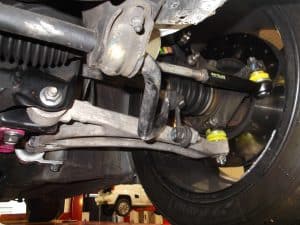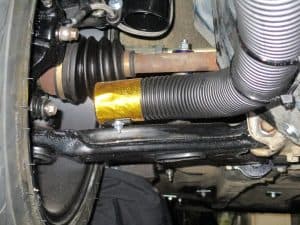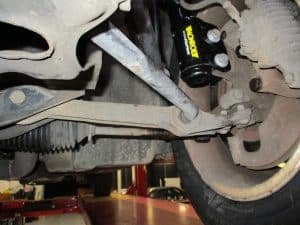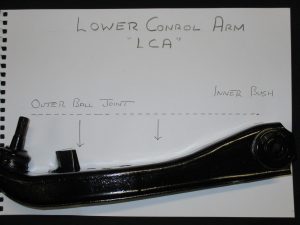TUNING POWER OF THE
FRONT LOWER CONTROL ARM
(LCA)
It has been on my mind for some time now to share a topic of often friendly discussion & debate. I am referring to the incredible importance of understanding and using the geometry of the “Front Lower Control” (LCA) in the front suspension for optimising suspension geometry for maximum tyre grip and handling performance.
For this post l am making particular reference to the MacPherson strut suspension. While the Double A Arm configuration shares some geometry similarities, there are significant operational differences when comparing the two systems over the spectrum of a suspension travel operating range.
Not only an important locator in this simple suspension, the LCA and with reference to its position and angle will have a profound impact on many aspects of the front suspension geometry during dynamic phases of on road and track operation. When chassis tuning race cars we must realise the importance and tuning power of the LCA and build this knowledge into the first stages of our set up.
For me now and how l have evolved with my methods of chassis tuning procedures, l find the LCA has become in almost all cases my starting point with any new set up. All other procedures then follow. I wish to explain this with focus on two critical elements.
2/ Camber gain: A massive downfall the MacPherson strut suspension suffers from is undesirable camber loss (an increase in positive camber) when a car is excessively lowered and as the suspension compress’s into its bump travel. All well engineered suspension systems will feature camber gain (an increase in negative camber) on the outside wheels of a corner as the loaded suspension is forced into bump. With optimum LCA geometry, the MacPherson strut suspension by design will give some camber gain in its first stages of travel however, it soon diminishes and reverses with increasing bump. Incorrectly setting of the LCA only results in a suspension that delivers camber loss (Positive camber) over the entire suspension compression (Bump) travel range. Tyre camber is everything for grip and a suspension with camber gain will compensate for static set camber which is lost with body roll. Yes, negative camber when you need the most, on the limit when cornering.
This is the secret for the best possible camber curve. In all cases l know off, set the outer lower ball joint lower than the inner pivot (bushing) or at a bare minimum at least keep the LCA level with the vehicle resting on all 4 x wheels at ride height. Optimum is the LCA angled down at the ball joint end. The objective is to maximise and make the most of suspension camber gain and we only have a small window of LCA angle to work with.
2/ Roll centre: Secondly we must consider the issue of the vehicles “roll centre” and the implications the LCA has on determining this point. This is a massive issue. A roll centre could easily be another discussion on its own and that’s ok…. For now, here are some basics to launch out of the starting blocks. The vehicle roll centre is a virtual point. You cannot see it though it is calculated via suspension geometry measurement and is the a point / line in space in which vehicle body rolls / pivots from with forces applied from the centre of gravity point. Once again the position / angle of the LCA is a primary factor in the equation for roll centre location. Any deviation from the LCA original manufactures positioning will impact on roll centre. Excessive vehicle lowering will raise the outer ball joint well above the inner pivot bush and destroy optimum roll centre height. In all cases the roll centre will be pushed down and this virtual point can even end up below the ground. This situation will result in an increase in the body roll moment forces with the suspension springs resisting all lateral forces and significantly increasing the body roll angle. The secret to maintain a favourable roll centre is to again angle the LCA down at the ball joint end. We can further aid and improve the roll centre position through the fitment of roll centre ball joints. These essentially are longer / extended length ball joints that re position the LCA arm ball joint down resulting in a higher roll centre location.
As can be appreciated from the above, a roll centre kit is just so much more and could also be marketed as a “camber gain fix” It is just so incredibly important to note that excessive vehicle lowering with the McPherson strut suspension will destroy desired suspension geometry.
It’s not all about having a low car. If having an excessively low car is your only consideration when setting up your car and you ignore vital suspension geometry aspects you will forever find yourself in a world of pain trying to be the quickest car around corners.
3/ Starting off: As a starting point for setting ride heights I strongly suggest you place strong emphasis in using your LCA as a gauge and measuring tool in this equation. You may end up with a higher ride height than you envisaged and truly not the race car low look you think you should have. Thats OK…. Remember, we are starting off and this is just a guide in optimising one particular aspect of this suspension. Every car is different and there will ultimately be compromises. OK, once the front ride has been set then proceed to the rear ride height settings with the objective now to dial in some body rake angle. I suggest 15-20mm higher at the rear with the lower sill or rocker panel being a very good point to gauge this from. A body rake angle is critical in terms of aero management and minimising a build up of air pressure under the vehicle.
To conclude it is very true to say that the set up of a race car is the balance and development of the whole chassis and all associated systems. Yes, we need to be considering just so much. The LCA is only just one small aspect to consider. Though this method of setting the LCA will at least improve the limitations of this suspension design.
I truly hope this insight into the lower control arm will just at a bare minimum help all interested persons commence a more successful suspension set up with emphasis on a far greater understanding of setting ride heights and the implications this may have on suspension geometry.




